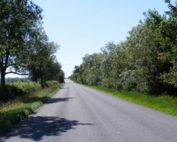Grantham and the Great North Road
Grantham’s fortunes have been closely linked to those of the Great North Road. Enjoying a boom as a coaching stop then retreating into relative obscurity as the railways and bypasses have sped traffic on its way to the cities north and south.
The early North Road had followed Roman Ermine Street along the limestone edge a mile or two east of the town with traffic going to York via Lincoln and a ferry crossing the Humber. The Gough map of about 1360 shows that the North Road passed through Grantham. Traffic would have increased with the building of the bridge over the River Trent at Newark.
About Grantham
Place names near to Grantham (Barrowby, Gonerby and Somerby) indicate that this area started to gain significance in Viking times. The Domesday Book records Grantham as having a population of 1,100. The town developed during the medieval period as a centre for the wool trade and by the early 1300s had acquired an impressive church with a 282 foot spire.
Grantham was one of the 12 stops made by Edward I when he transported the body of Queen Eleanor from Lincoln to London for burial after her death in 1290. The Eleanor Cross that he erected at Grantham was destroyed during the civil war.
In 1686 a War Office return found 285 guest beds in the town and stabling for 351 horses. In 1725 the road north from Grantham was turnpiked and the road south to Stamford followed in 1739. In 1797 the Grantham Canal opened to navigation, linking the town with Nottingham and the Trent.
The Angel was just one of the many inns which prospered with the coaching trade. Founded in about 1203 as a hostel for the chivalrous Brotherhood of the Knights Templar the inn was extended in the mid 14th Century and again in the 15th Century. As the Angel and Royal it remains a popular hotel to this day.
By the end of the 18th century the Mail Hotel in the High Street was another leading inn with coaches to York, Newcastle, Edinburgh, Scarborough, Whitby and Carlisle. The fare on the fastest stage coach to London, the York Mail, was £1 16s 0d for an inside seat, and the journey took 16 hours. The cheapest price was 14s for a seat ‘outside’ on the Highflier, which left Grantham at 6 pm and arrived in London at 12 o’clock the next day. By 1826 there were more people running hotels and taverns than were engaged in any other single trade.
Grantham has played its part in our scientific, industrial and political history.
In 1642 Isaac Newton was born in Woolsthorpe near Grantham and attended the famous King’s School in Grantham
During the 19th century local engineering business Richard Hornsby was a major innovator producing diesel engines before Rudolf Diesel and caterpillar tracked vehicles before Caterpillar.
Former prime minister Margaret Thatcher was born in Grantham in 1925. Her parents owned a grocers shop on North Parade on the edge of the town centre.
Statues of Isaac Newton, Frederick Tollemache and Margaret Thatcher. Image Credit – Rex Gibson
Explore Grantham
The images below provide links to additional information either on this website or elsewhere.
Grantham Then and Now


Cribb v Molineaux
The Cribb v Molineaux boxing match to decide the English title took place close to the Great North Road in 1811. It is claimed to have drawn a crowd of 20,000 to a field at Thistleton...
Gonerby Hill
Novelists of the 19th century ensured that Gonerby Hill became a firm part of Great North Road folklore. William Harrison Ainsworth, a fellow writer and friend of Dickens...
The Ram Jam Inn
The Ram Jam at Stretton grew from being a modest village inn to a Great North Road institution. Where did the "Ram Jam" name come from? And what's the link...
Burghley House
The route of Ermine Street runs through the Burghley estate and remains a public footpath. The Great North Road ran alongside the estate as the road winds...
The Eleanor Crosses
The Eleanor Crosses constructed in the 1290s to commemorate the passing of the queen were prominent landmarks alongside the Great North Road at Grantham...
The Angel Inn, Grantham
The Angel Inn traces its roots back to a hostel built in 1203 by the Knights Templar; this was a military/religious order which supported those fighting the Crusades or...
The George, Stamford
The George at Stamford vies with the Angel at Grantham as the country’s oldest surviving coaching inn. Its distinctive wooden arch over the Great North Road...
Ermine Street
The southern section of Ermine Street aligns closely with the Old North Road, merging with Great North Road near Godmanchester, before heading eastwards...
RAF Wittering
RAF Wittering is located just south of Stamford, Lincolnshire. It was the “Home of the Harrier” and for several decades has been marked by a Harrier Jump Jet anchored...
Wansford – Bauhaus
This Bauhaus inspired building has been a notable feature for travellers on the Great North Road since it was constructed in the early 1930s. It has seen.....














